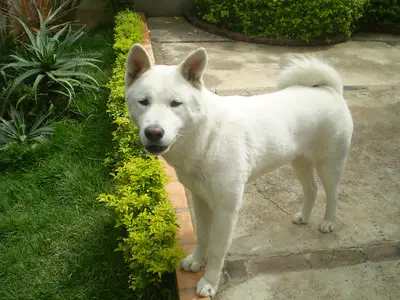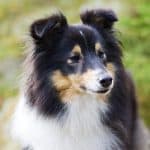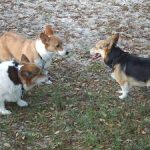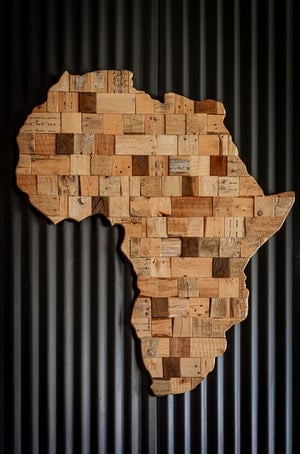
Africa is a massive continent. It is large enough to fit in the U.S., China and India with some room to spare.
But for such a vast area, it is perhaps a surprise that only eleven dog breeds are thought by some to have originated in Africa.
Particularly because research has shown that Africa might have been the area in which dogs were domesticated first.
And in this article, I highlight seven of the largest African dog breeds.
The largest and heaviest breed in this selection has to be the Boerboel which at up to 28 inches tall and 200 lbs in weight is one of the bulkiest dogs that you will find on any continent.
The smallest breed on my list is the Basenji, which stand 17 inches tall and weighing 24 lbs.
And between these two breeds are a motley crew of breeds- some heavyweights and others more lightweight.
But I want to start my list with the biggest breed.
Boerboel
If you’re looking for a large guard dog, a Boerboel might just be the right pet for you. They’re pretty intimidating only to look at, with an adult male reaching up to 28 inches (71 cm) in height and weighing between 110 and 200 pounds (50 – 90 kg). An intruder would be well advised to stay away from a house where there’s a Boerboel as this is a no-nonsense dog who got his guarding skill back in South Africa where his ancestors came from.
This huge dog got his name from the Dutch settlers who went to South Africa in the 1600s and needed fierce animals to protect their farms from dangerous predators. The Boerboel appeared as a result of breeding Bulldog types with Mastiff dogs to create a strong, confident guarding dog. If you listen to old South African tales Boer dogs are strong enough to kill a lion, but, according to AKC experts, such claims might be a bit far-fetched. At most, they say, a Boerboel might manage to kill a leopard. Still good enough for any person looking to protect his home and family against bipedal intruders.
As fierce as Boerboels might sound, they are good pets, as they are bright, highly-trainable and affectionate with their immediate human family. Keep in mind that such a large hard-working dog requires plenty of exercise and needs a large backyard to roam freely.
Rhodesian Ridgeback
Fast and athletic, the Rhodesian Ridgeback is the sort of dog you don’t want to mess with. The Rhodesian Ridgeback descends from a breed of ferocious South African hunting dogs, belonging to the Khoikhoi tribe who lived in the area of the Cape Peninsula. When the Dutch settlers arrived in Southern Rhodesia (modern Zimbabwe) they bred this native dog with various types of European guard dogs. Genetic analysis established that the Rhodesian Ridgeback is closely related to the Great Dane, hence its impressive stature. The male of this breed weighs around 88 – 110 lbs (40 – 50 kg) and reaches between 25 – 31 inches (63 – 79 kg).
The dog takes his name from the strip of hair on his back which grows backwards, forming a ridge. Typically, Rhodesian Ridgebacks have a short dense coat, which can be of every shade between light wheaten and deep red.
Such dogs are excellent guardians. While friendly and loyal to their owners, Rhodesian Ridgebacks watch any foreigner with suspicion, although they do not attack unprovoked.
They like to learn new things, which makes them easy to train but they have a strong sense of justice and will suffer greatly if they feel they were punished for no reason.
Azawakh
This is not your typical guard dog, that’s for sure. An Azawakh looks deceptively thin, you can almost feel his ribcage under the short fine coat, but he is quite athletic and extremely quick. The Azawakh originates from the Western coast of Africa and is closely associated with the Tuareg and other nomadic populations in countries like Mali, Nigeria and Burkina Faso. In past centuries dogs of this breed were used as sighthounds. The locals call this type of dog “idii n’ illeli’, which means the sighthound of the free people. These do not hunt by scent, but by spotting the prey and sprinting after it at a speed of 40 miles per hour. An adult male stands 25–29 in (64 – 74 cm) tall but due to its very long legs only weighs around 44 – 55 lbs (20 – 15 kg).
Azawakh dogs are extremely attached to their owners and very protective of them, but keep their distance when they meet a stranger.
When choosing to get such a pet, you should consider the climate in your area. As dogs of the desert, Azawakhs hate rain and cold weather.
Basenji
Although they were hunting dogs originally, Basenji dogs are well adapted to apartment living and are low-maintenance as pets. Except of course for their high exercise needs, they’re very energetic and love to practice their skills by chasing an interesting scent. The Basenji come from Congo, where they are known as ‘dogs of the savages’ or the ‘dogs that jump up and down’. This odd name comes from the fact that these dogs need to jump a lot to spot their prey, as they are not all that big. An adult male is around 17 in (43 cm) tall and weighs no more than 24 lbs (11 kg). It is not unusual to see a Basenji standing on two feet like a meerkat when looking out for prey.
One of the most interesting traits of Basenji dogs is they tend to howl and yodel rather than bark. Not that they don’t want to bark, it’s just that they have a very weird-shaped larynx which doesn’t allow them to. It is believed the Basenji were bred to be barkless, as too much barking would have attracted predators to their nomad owners. This is a trait that makes them a good choice as pets if you live in an apartment building.
Sloughi
This is one of the fastest dogs you’ll ever find. Also known as the Arabian Greyhound, Sloughi belongs to the sighthound group and when they spot their prey they can dash after them at an amazing speed of up to 32 miles per hour (50 kph). Sloughi dogs trace their roots back to Morocco, Algeria and Libya in Northern Africa, where they were used by the Berber and Bedouin populations to hunt hares, gazelles or foxes. A male Sloughi reaches 24 – 29 in (60 – 73 cm) in height and weighs 40 – 63 lbs (18 – 28 kg).
Dogs of this breed have a fine short coat and come in a variety of colors, from light sand to fawn, sometimes with a black mask on their heads. They are very affectionate with their owners, when they care to, and are generally good with kids, although not small ones who do not understand boundaries.
Saluki
One of the most elegant of the many sighthound breeds, the Saluki dog originates in the Middle East area (Iraq, Syria, Lebanon, Israel and Palestine), although it is more closely related to the Afghan hound rather than other African hunting dogs. Males of this breed grow up to 23–28 inches (58–71 cm) and weigh around 40 – 60 lbs (18 – 27 kg). Saluki dogs have the typical long (and very fast ) legs of sighthounds and they come in a variety of colors, from pure white or cream to tricolored coats of white, black and tan.
In 1996, a Saluki dog made it to the Guinness Book of Records as the fastest dog living, after reaching a speed of 68.8 km/h (42.8 mph). You need to train such a dog well, as you don’t stand a chance of catching him if it doesn’t come when called. On the other hand, they’re very devoted as pets and can even fit into an apartment, although you will need to provide them plenty of opportunities to exercise and even chase a squirrel to satisfy their hunting instincts.
African Wild Dog
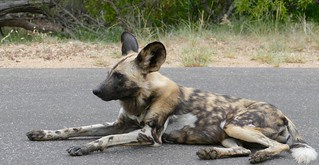
With its distinctive large bat-like ears and its patchy coat, the African Wild dog, also known as the painted wolf, is among the world’s most endangered mammals world’s most endangered mammals. This type of dog can be found in the Southern parts of the African continent, but their numbers are rapidly dwindling due to loss of their natural habitat and infectious diseases. African Wild dogs reach up to 30 inches (76 cm) in height and weigh between 40 and 70 lbs (18 – 31 kg).
They live in packs, ranging from 10 to 40 members and they are known as opportunistic predators. They hunt what they can get, which is mostly gazelles. As they wouldn’t hesitate to attack farm animals, farmers shoot them on sight, which is another reason this breed is threatened with extinction. Unlike many other social animals, in African Wild dog packs it is the females that leave the group once they become sexually mature. They join other packs and evict some of the females, which is a very clever way of limiting inbreeding.
African Wild dogs figure prominently in African mythology, where they are sometimes associated with the origin of death. Some tribes believed the gods can transform them into wild dogs after death, while to this day many local hunters smear their feet with body fluids of these dogs to gain their abilities.
These close ties with the local population forged over millennia don’t make modern African people more sensitive to their plight and unless strong action is taken the African Wild dog will soon become extinct.

